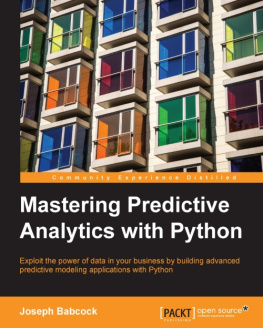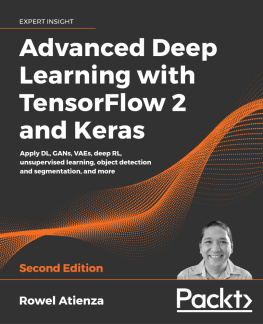Joseph Babcock - Generative AI with Python and TensorFlow 2: Create images, text, and music with VAEs, GANs, LSTMs, Transformer models
Here you can read online Joseph Babcock - Generative AI with Python and TensorFlow 2: Create images, text, and music with VAEs, GANs, LSTMs, Transformer models full text of the book (entire story) in english for free. Download pdf and epub, get meaning, cover and reviews about this ebook. year: 2021, publisher: Packt Publishing, genre: Computer. Description of the work, (preface) as well as reviews are available. Best literature library LitArk.com created for fans of good reading and offers a wide selection of genres:
Romance novel
Science fiction
Adventure
Detective
Science
History
Home and family
Prose
Art
Politics
Computer
Non-fiction
Religion
Business
Children
Humor
Choose a favorite category and find really read worthwhile books. Enjoy immersion in the world of imagination, feel the emotions of the characters or learn something new for yourself, make an fascinating discovery.
- Book:Generative AI with Python and TensorFlow 2: Create images, text, and music with VAEs, GANs, LSTMs, Transformer models
- Author:
- Publisher:Packt Publishing
- Genre:
- Year:2021
- Rating:3 / 5
- Favourites:Add to favourites
- Your mark:
Generative AI with Python and TensorFlow 2: Create images, text, and music with VAEs, GANs, LSTMs, Transformer models: summary, description and annotation
We offer to read an annotation, description, summary or preface (depends on what the author of the book "Generative AI with Python and TensorFlow 2: Create images, text, and music with VAEs, GANs, LSTMs, Transformer models" wrote himself). If you haven't found the necessary information about the book — write in the comments, we will try to find it.
Fun and exciting projects to learn what artificial minds can create
Key Features- Code examples are in TensorFlow 2, which make it easy for PyTorch users to follow along
- Look inside the most famous deep generative models, from GPT to MuseGAN
- Learn to build and adapt your own models in TensorFlow 2.x
- Explore exciting, cutting-edge use cases for deep generative AI
Machines are excelling at creative human skills such as painting, writing, and composing music. Could you be more creative than generative AI?
In this book, youll explore the evolution of generative models, from restricted Boltzmann machines and deep belief networks to VAEs and GANs. Youll learn how to implement models yourself in TensorFlow and get to grips with the latest research on deep neural networks.
Theres been an explosion in potential use cases for generative models. Youll look at Open AIs news generator, deepfakes, and training deep learning agents to navigate a simulated environment.
Recreate the code thats under the hood and uncover surprising links between text, image, and music generation.
What you will learn- Export the code from GitHub into Google Colab to see how everything works for yourself
- Compose music using LSTM models, simple GANs, and MuseGAN
- Create deepfakes using facial landmarks, autoencoders, and pix2pix GAN
- Learn how attention and transformers have changed NLP
- Build several text generation pipelines based on LSTMs, BERT, and GPT-2
- Implement paired and unpaired style transfer with networks like StyleGAN
- Discover emerging applications of generative AI like folding proteins and creating videos from images
This is a book for Python programmers who are keen to create and have some fun using generative models. To make the most out of this book, you should have a basic familiarity with math and statistics for machine learning.
Table of Contents- An Introduction to Generative AI: Drawing Data from Models
- Setting Up a TensorFlow Lab
- Building Blocks of Deep Neural Networks
- Teaching Networks to Generate Digits
- Painting Pictures with Neural Networks Using VAEs
- Image Generation with GANs
- Style Transfer with GANs
- Deepfakes with GANs
- The Rise of Methods for Text Generation
- NLP 2.0: Using Transformers to Generate Text
- Composing Music with Generative Models
- Play Video Games with Generative AI: GAIL
- Emerging Applications in Generative AI
Joseph Babcock: author's other books
Who wrote Generative AI with Python and TensorFlow 2: Create images, text, and music with VAEs, GANs, LSTMs, Transformer models? Find out the surname, the name of the author of the book and a list of all author's works by series.







